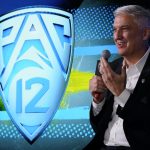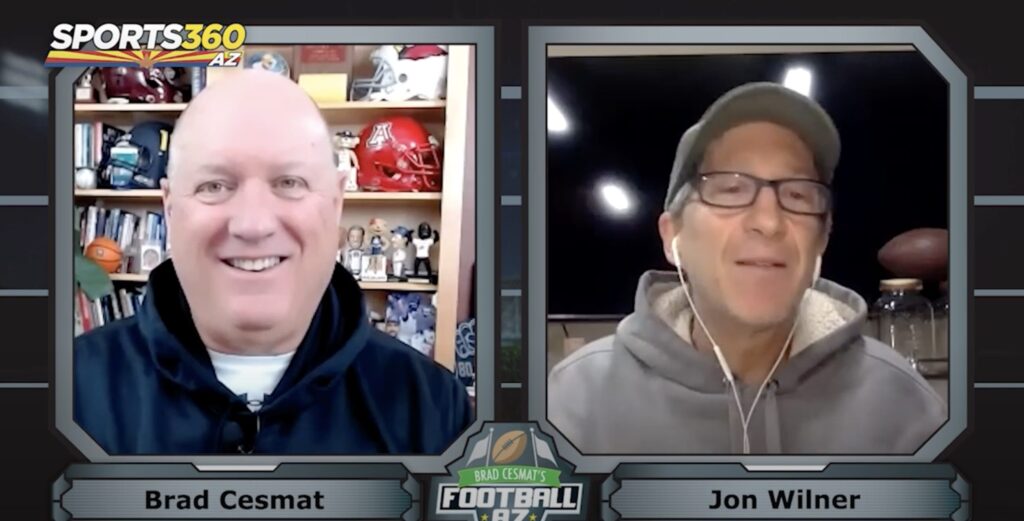Clearly, Pac-12 commissioner George Kliavkoff worked against the interests of the two remaining schools (and on behalf of the 10 departing schools). Why wouldn’t Washington State and Oregon State fire him immediately — for cause — and install a highly-respected, proven leader like WSU president Kirk Schulz as commissioner of the “new” conference? — Jim Varnell
Kliavkoff would tell you that he took a neutral position on the matter, but his actions suggest otherwise — and the courts seemed to agree.
In ruling WSU and OSU were the sole members of the Pac-12 board of directors, a Washington state superior court in Colfax and the Washington Supreme Court in Olympia clearly believed the 10 departing schools relinquished their board seats upon announcing they were joining new conferences.
(There was a truckload of real-world evidence to support that view, starting with the actions the conference took when USC and UCLA announced their departures in the summer of 2022.)
Kliavkoff’s early-September push to call a board meeting of all 12 schools, therefore, could be viewed as traitorous — a move that acted against the best interests of the Pac-12 — because WSU and OSU were the Pac-12.
Which means there could be a case to terminate Kliavkoff for cause and potentially avoid paying the remaining $8 million on his contract. (To be clear: That’s an approximation based on our guess that he signed a five-year deal at $3.5 million annually.)
However, any attempt to terminate Kliavkoff for cause would assuredly result in a lawsuit and, ultimately, a negotiated settlement.
Because all 12 schools must share in liabilities, the difference between paying Kliavkoff his full buyout and a settlement amount would be negligible (on a per-campus basis). It’s likely several hundred thousand dollars per school.
Is that worth the effort of taking a hard line and paying more attorney fees?
Would the presidents want to deal with the discovery process and any dirty laundry that might surface?
We’re skeptical.
While there’s clearly a case to be made that Kliavkoff acted against the best interest of the Beavers and Cougars, all 12 schools undoubtedly want the cleanest break possible on as many fronts as possible.
They want to move on.
Firing Kliavkoff for cause might be emotionally satisfying for fans and campus officials in Pullman and Corvallis, but it doesn’t achieve the goal.
In fact, it makes the desired outcome more difficult to achieve.
Why haven’t you asked the Oregon State and Washington State athletic directors why Kliavkoff went to the meetings in Washington, D.C. with other commissioners? And why haven’t you asked them what the future is with Kliavkoff? — @jimmy0726
You’re assuming we haven’t asked that very question: Why is the zombie commissioner still employed?
And we have asked, several times. But OSU president Jayathi Murthy and WSU’s Schulz are keeping their plans private, which makes sense given the sensitive nature of employment contracts.
In our estimation, Kliavkoff remains in charge because he serves at least one purpose.
The Pac-12 will continue to operate as a conference after the 10 schools depart next summer. Someone needs to represent WSU and OSU in meetings on critical national matters, from the future format of the 12-team College Football Playoff to potential Congressional legislation on NIL and the employment status of athletes.
Should WSU and OSU trust that Kliavkoff will work on their behalf given his previous actions? At this point, with the courts having determined the makeup of the board, he has no reason to undermine their best interests.
Also, his replacement likely would be far less informed on the issues, which could be problematic for OSU and WSU.
You mentioned Schulz for the role, but what would be gained?
He’s already running the conference, alongside OSU’s Murthy, without having to deal with the day-to-day issues that come with being a commissioner. (Presumably, Schulz enjoys being a university president. After all, he recently took charge of the entire WSU system.)
Whenever the board dismisses Kliavkoff — maybe it’s next week, or next month, or sometime this spring — there’s an obvious replacement available: Teresa Gould, the Pac-12’s deputy commissioner.
Gould already oversees many of the day-to-day issues; she has a solid working relationship with OSU and WSU; and she has a far deeper understanding of college sports than Kliavkoff.
The Pac-12 office must continue to operate, in some fashion, once the 10 schools depart. We expect Gould to lead those operations, assuming she wants to remain with the conference.
So if Florida State, Clemson, North Carolina and Virginia leave the ACC in the next one or two years, does that open an avenue for Cal and Stanford to return to the Pac-12? You may have covered this already, but I don’t recall seeing it in your column. — Mike Arao
The ACC is on fragile ground, and Stanford and Cal committed to that shaky terrain for 12 years — most of them with significantly less media rights revenue than their peers. (In other words: They took a gigantic risk.)
We see one of four scenarios playing out:
1. The ACC remains intact for the duration of its contract cycle with ESPN (through 2036), which would be optimal for the Bay Area tandem.
2. With Florida State’s lawsuit as the spark, the top football schools depart the ACC in a few years and leave behind a greatly depleted league that generates negligible media revenue and includes the Bay Area schools.
3. The departure of the ACC’s top football schools leads to the complete dissolution of the conference, freeing Stanford and Cal from their contractual commitment — and allowing them to rejoin the Pac-12.
4. College football undergoes a radical transformation in which all the power conferences dissolve and a super league, or separate subdivision, is formed.
The worst outcome for the Bay Area schools? No. 2.
That’s not necessarily the most likely endgame — it’s anyone’s guess as to how this whole thing might play out. But it’s the worst scenario for the two schools, by far.
When will the Big Ten publish its 2024 football TV schedule? Where will we expect to find the games (i.e. mostly on the Big Ten Network, or elsewhere)? — @RobSton03655041
The kickoff times and TV networks for the early-season Big Ten games will be announced in the spring (likely May) — and that’s the case for the SEC, Big 12 and ACC, as well.
Broadcast details for the matchups starting in late September will be announced during the season, just as they have been for years.
The Big Ten has three primary TV windows (PT): 9 a.m. on Fox, lunchtime on CBS and late afternoon on NBC.
There will be some exceptions to that lineup, plus broadcasts on Peacock, the NBC streaming service. And the Big Ten Network will show a heavy load of games each week, as well.
Generally speaking, the matchups will be easy to find for viewers from coast to coast.
My sense is that all the players entering the transfer portal on the 30-day window (e.g. Washington, Arizona, Alabama) are doing so largely to test the market financially and leverage the current or future schools. Call me cynical, but it sounds more financial than about an institutional or coach fit. Am I wrong? — Alex F
That’s precisely the reason behind most, although not all, transfer decisions.
The players are lured into the portal by cash offers from other schools — offers that may or may not be legitimate.
And it’s about to get more chaotic. An ongoing legal challenge to the NCAA’s transfer policy is expected to result in immediate eligibility for multi-time transfers. (The Department of Justice has joined the suit, by the way.)
So if a quarterback — let’s call him Matthew Denix Jr. — plays one year for Team X, then transfers to Team Y and plays immediately, he would need to sit out a year if he transfers to Team Z (unless he’s a graduate student).
But if the plaintiffs are successful, then Denix could transfer to Team Z and play immediately as an undergraduate.
It’s free agency 2.0, and it will have a 100-fold impact on roster construction.
I really liked the conversation on your podcast about judging coaches more by how they leave a school than how they arrive. Great perspective. — @gohuskies1978
Appreciate that.
Two components are worthy of additional mention:
— It’s more difficult for fans to accept the change when a coach leaves for another job, as was the case last month with Washington’s Kalen DeBoer and Arizona’s Jedd Fisch. Retirements and terminations are easier on the psyche.
— Everything about the process, for all schools regardless of the specific circumstances, is more difficult because of the transfer portal and NIL. The moment the head coach departs, it’s open season on the roster.
And because most of the players (understandably) prioritize the financial piece, they are vulnerable to being lured away from what appear to be favorable situations.
How about some hoops love? The Pac-12 is not good. Is USC’s Andy Enfield on the hot seat? Does Oregon need to make the tournament to save Dana Altman? Is this the last stand for ASU’s Bobby Hurley, Washington’s Mike Hopkins and Stanford’s Jerod Haase? — @boscpenn83
The Hotline is planning to examine this very topic next week — a look at the Hot Seat situations across the conference as the stretch run begins.
There are a handful of Hot Seats because, well, the quality of coaching isn’t very good. And it hasn’t been good for many years.
Which is why Pac-12 basketball has been irrelevant for many years, save for three miraculous weeks in March 2021.
By the close of March 2024, we expect several schools to have new coaches.
*** Send suggestions, comments and tips (confidentiality guaranteed) to pac12hotline@bayareanewsgroup.
*** Follow me on Twitter: @WilnerHotline
*** Pac-12 Hotline is not endorsed or sponsored by the Pac-12 Conference, and the views expressed herein do not necessarily reflect the views of the Conference.
Related posts:
 Hotline mailbag – On the “big bias” with ESPN, the Pac-12’s low bid total, Kriisa’s injury, Fox and Haase remain in place and more
Hotline mailbag – On the “big bias” with ESPN, the Pac-12’s low bid total, Kriisa’s injury, Fox and Haase remain in place and more

(AP Photo/Ralph Freso, File)
Wilner Hotline – Pac-12 survival guide: The strategic merits of an alliance (or merger) with the Big 12
(AP Photo/Ralph Freso, File)
Wilner Hotline – Presidential Power Index: Which Pac-12 presidents have the greatest influence over the conference’s future
(AP Photo/Marcio Jose Sanchez)
Wilner Hotline – The Pac-12’s survival depends on the Big Ten, not the Big 12: Tracing the path to stabilityJon Wilner
Jon Wilner has been covering college sports for decades and is an AP top-25 football and basketball voter as well as a Heisman Trophy voter. He was named Beat Writer of the Year in 2013 by the Football Writers Association of America for his coverage of the Pac-12, won first place for feature writing in 2016 in the Associated Press Sports Editors writing contest and is a five-time APSE honoree.
